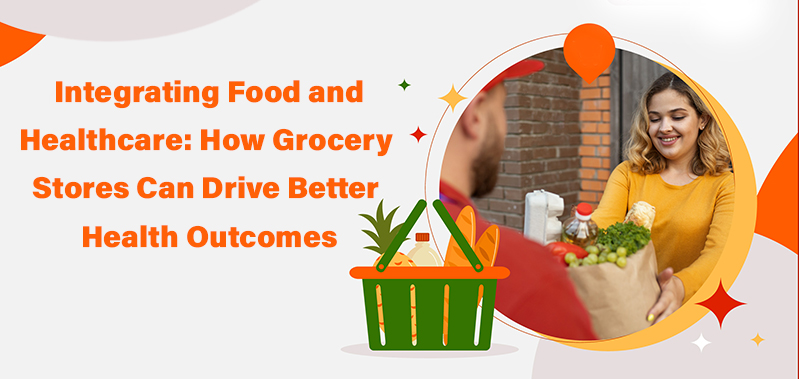
Integrating Food and Healthcare: How Grocery Stores Can Drive Better Health Outcomes
Health is a much more important topic in food retail today, and for good reason: consumers have placed it at the front and center of the market. Consumers are passionate about embracing health in many aspects of their lives, and food is a big part of this. As healthcare costs soar and chronic diseases become increasingly prevalent, a transformative idea is gaining traction: integrating food and healthcare. Grocery stores, long considered mere hubs for food shopping, are now at the forefront of this innovative approach. By fostering healthier eating habits, offering preventive care services, and partnering with healthcare providers, grocery stores have the potential to significantly enhance public health outcomes.
The Biden administration recently announced its goal of ending hunger, reducing diet-related illnesses, and addressing health disparities by 2030. Strategies include nutritional education for people who are enrolled in Medicaid and Medicare, updated labeling to make it easier for consumers to identify healthy foods, and incentives that encourage people to buy more fruits and vegetables.
This is an ambitious goal, and changes will likely need to be made inside and outside of the government. Many grocery store chains and the National Grocers Association have joined this effort.
Key Strategies for Grocery Stores to Drive Better Health Outcomes
Medically tailored meals and home-delivered meals for at-risk populations: Providers and payers are implementing innovative and integrated ways to ensure that their members can access nutritious foods, especially for those with limited mobility and chronic disease. This approach has taken on many forms, including the launch of a bipartisan Food is Medicine Working Group in the House of Representatives in 2018. Members of the group introduced the Medically Tailored Home-Delivered Meals Demonstration Pilot Act of 2020. Medically tailored meals (MTMs) are delivered to individuals living with severe illness through a referral from a medical professional or healthcare plan. Meal plans are tailored to the medical needs of the recipient by a Registered Dietitian Nutritionist. They are designed to improve health outcomes, lower the cost of care, and increase patient satisfaction.
Prescriptions and subsidies for fresh produce: Providers are uniquely positioned to understand their patient’s nutrition needs, especially those living with or at risk for chronic health conditions. In these cases, providers can prescribe vouchers or targeted financial assistance for discounted or no-cost produce. Prescriptions can be redeemed at retail grocers, farmers markets, or within Community Supported Agriculture programs. This approach not only increases individuals’ and families' purchasing power and autonomy but also supplements and extends existing food security programming and supports local food retailers. Producing prescriptions through health providers can improve overall health.
Healthy food financing initiatives: Healthy food financing initiatives (HFFI) are public-private partnerships designed to improve access to nutritious food in underserved areas. HFFI provides food retailers with the resources needed to overcome higher costs and initial barriers to selling fresh produce to underserved areas. Traditionally, these funds are provided by local, state, and federal government entities and managed by a Community Development Financial Institution. The latter leverages private capital and makes loans and grants to projects slated for low-income areas that lack access to healthy food retail. HFFI has expanded the availability of nutritious foods in grocery stores, small retailers, corner stores, and farmers' markets. The federal HFFI program has leveraged more than $220 million in grants and an estimated $1 billion in additional financing. The initiative has supported nearly 1,000 healthy food retail projects in more than 35 states across the country, improving access to nutritious food, creating jobs, and revitalizing economies by attracting new development.
Future policy opportunities and actions
While food insecurity is a complex, long-standing problem in the U.S., the pandemic has provided greater visibility to this issue and garnered public support for addressing barriers to food access and affordability. Because food insecurity has a disproportionate impact on low-income and communities of color, it is essential for all solutions and interventions to center around the needs and values of these individuals, families, and communities. Ultimately, greater economic security is needed so that fewer people require food assistance. For those who do need help, advocates discuss the importance of expanding eligibility criteria for nutrition programs and making the application process easier to navigate. There are many opportunities for building evidence and developing robust, root-cause, and cross-cutting solutions.
This paper highlights several approaches that can help remove structural barriers to obtaining healthy food. Healthcare leaders, policymakers, and advocates are working to promote innovations and reforms, including those introduced during the pandemic, that prioritize high-risk communities and households and reduce long-standing inequities. Together, leaders can reframe the food narrative to focus on and improve the availability of affordable and nutritious food across the country.




